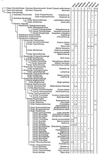Late changes in spliceosomal introns define clades in vertebrate evolution
- PMID: 10468597
- PMCID: PMC17877
- DOI: 10.1073/pnas.96.18.10267
Late changes in spliceosomal introns define clades in vertebrate evolution
Abstract
The evolutionary origin of spliceosomal introns has been the subject of much controversy. Introns are proposed to have been both lost and gained during evolution. If the gain or loss of introns are unique events in evolution, they can serve as markers for phylogenetic analysis. We have made an extensive survey of the phylogenetic distribution of seven spliceosomal introns that are present in Fugu genes, but not in their mammalian homologues; we show that these introns were acquired by actinopterygian (ray-finned) fishes at various stages of evolution. We have also investigated the intron pattern of the rhodopsin gene in fishes, and show that the four introns found in the ancestral chordate rhodopsin gene were simultaneously lost in a common ancestor of ray-finned fishes. These changes in introns serve as excellent markers for phylogenetic analysis because they reliably define clades. Our intron-based cladogram establishes the difficult-to-ascertain phylogenetic relationships of some ray-finned fishes. For example, it shows that bichirs (Polypterus) are the sister group of all other extant ray-finned fishes.
Figures



References
MeSH terms
Substances
Associated data
- Actions
- Actions
- Actions
- Actions
- Actions
- Actions
- Actions
- Actions
- Actions
- Actions
- Actions
- Actions
- Actions
- Actions
- Actions
- Actions
- Actions
- Actions
- Actions
- Actions
- Actions
- Actions
- Actions
- Actions
- Actions
- Actions
- Actions
- Actions
- Actions
- Actions
LinkOut - more resources
Full Text Sources

